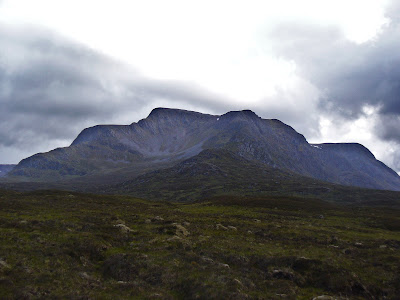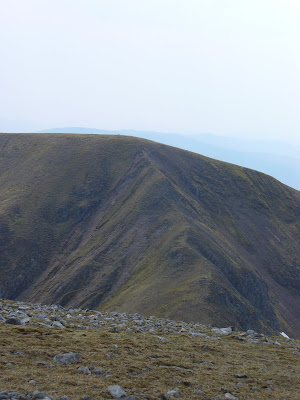
Ben Alder is one of the most remote and isolated mountains of the Southern Highlands of Scotland. Miles from any public road, and guarded on each side by mountains, lochs and great moors, it requires considerable effort even to see, never mind climb! Glimpses of Alder's dark shape are only usually glimpsed from the A9, as it passes the Dalwhinnie Distillery. Here the long glacial trench which holds Loch Ericht provides one brief line-of-sight through the tangled mountain architecture to great Ben Alder beyond. Many times I have looked down Loch Ericht, and longed to be heading out into the mountains again. Likewise, the sight of distant Ben Alder, (broad, rugged, remote, threatening) always seemed like a challenge, both awaiting completion and provocatively questioning my ability so to do!
Yesterday, Mr Pickering & I decided to accept the challenge. We packed rucksacks, bikes, cars, and went North, arriving at the level crossing by Dalwhinnie Station by 9:30. The long distances involved in penetrating the
Ben Alder Estate are made comparatively easy by the provision of well-maintained estate tracks. While not open to the public for vehicles, they enable the mountain-biker to cover the miles quite efficiently, and so by late morning we had passed Loch Pattack and Culra Bothy.
In retrospect it would have been worth retracing our steps, and crossing the footbridge over the Allt a Chaoil-reidhe. Deciding instead to peddle on past the bothy, we faced a tricky river crossing after abandoning the bikes. Mr Pickering crossed the river without difficulty, incident, or getting soaked. I only wish I could say the same about my effort to safely cross! A simple slip, a lack of grip, a misjudged leap between rocks and I was in. With more than ten-miles left to walk, and another ten+ to cycle, I was wet, my kit was wet, and my boots full of water. My feelings of irritation were suitably enhanced by the sight of Mr Pickering sitting on dry land chuckling merrily at the sight of my folly. He redeemed himself though, by producing from his rucksack (wonder of wonders!); a clean, dry pair of walking socks.
After a lunch break we followed the sketchy path which skirts Loch a Bealaich Bheithe, and terminates at the Bealach Breabag - the high point between Ben Alder and Beinn Bheoil. A steep (pathless) ascent from here, crosses the subsiduary top of Sron Bealach Beithe and then skirts the cliff edge above the Garbh Coire, corrie - leading to a jumble of cairns around the summit trig-point. The summit was bald, bleak, windblown and misty. The cloud cover was very patchy and intermittent though, and we enjoyed views on every side, especially of Schiehallion, The Lawers Group the Glen Lyon Hills, and out across the wilderness of Rannoch Moor. The worst view of Ben Alder is from its own summit, where its' great sculpted corries and scrambly ridges are almost entirely hidden below is huge domed top.

With conversation ranging through history, faith, politics, the Bible, children, business, education, and the foolishness of falling into fast-flowing rivers... we retraced our steps to the Bealach Breabag and contemplated the ascent of Sron Choire na h-Lolaire, the beginning of the undulating ridge leading to Beinn Bhoile. Beinn Bhoile is a charming mountain. Although overshadowed by the size of Ben Alder, Beinn Bhoile's steep, graceful ice-carved lines and position high above Loch Ericht would make it worth a visit in and of itself.

We stopped for tea on Beinn Bheoil enjoying what was fast becoming a very pleasant summer evening. The threatened three-to-four hours of steady rain had failed to materialise and even the heavy showers we could see building over Rannoch Moor were carried miles to the East of us by the westerly wind. The descent of Beinn Bheoil is fast and straightforward, once a little path running through the heather is picked up.
After completing a very careful, and thankfully dry river crossing, we re-gained the bikes and turned for home, feeling thoroughly splendid about the whole day's adventure. Once past Culra bothy and onto the good estate tracks we began to accelerate - the thought of getting to Pitlochry in time for the fish and chips freshly inspiring tired limbs! And then it happened...
Mr Pickering's rear tyre instantly and totally deflated. This didn't appear to be an insurmountable problem until we realised that neither of us had remembered the puncture repair kit - and the car was still almost 11 miles away!

In front of us the long road to Loch Ericht and then to Dalwhinnie looked impossibly long. Behind us, the great mass of Ben Alder looked majestic in the evening light, its' ridges all picked out by the low sunlight. I cycled on to the car, in order to get within mobile range and assure respective wives that we were OK and to prevent them phoning Mountain Rescue! Thankfully before I got to the car I met one of the estate workers who gave me the code to unlock the gate to drive right up the lochside to collect the weary looking Mr Pickering and his beleaguered bicycle.
Despite the bike, and the river we managed to complete our two-Munro, 51km expedition - and sped to Pitlochry in search of food. As we drove we could feel aching legs beginning to tense and stiffen up. We got out of the car at Pitlochry and did a kind of 'geriatric shuffle' to the chippy - to the obvious amusement of an onlooker who wryly chirped "you look like broken men". That's maybe how we looked, but the chat on the way home was all about how we might organise a trip to Culra bothy - and ascent of the four mountains on the other side of Ben Alder, which have so far evaded my exploration.


















































